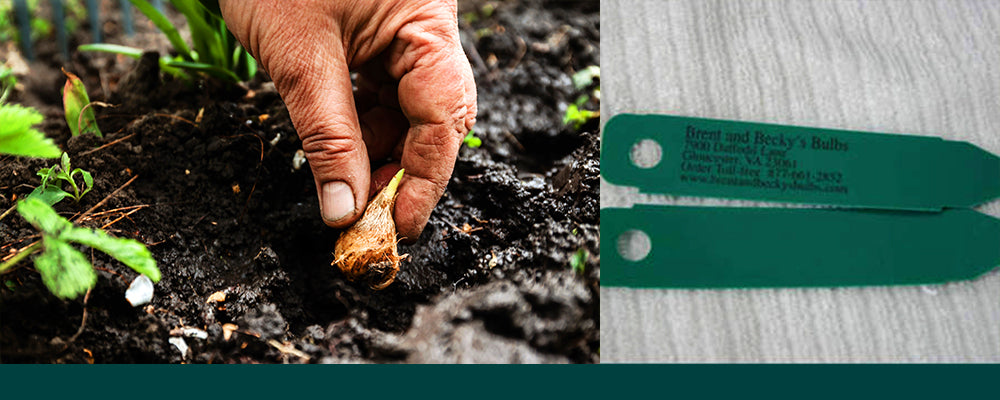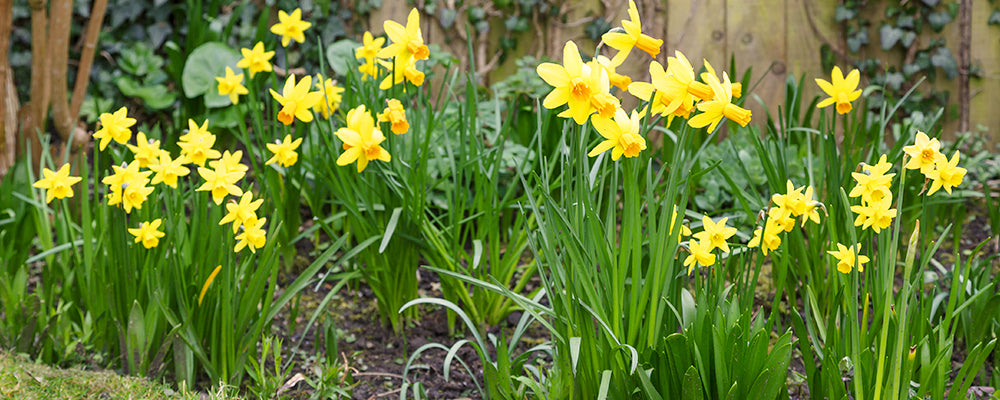Brent Answers Your Questions!
Posted by Brent & Becky's Admin on


Earlier this year, Brent took some time to answer the gardening questions you submitted on social media on the Brent & Becky’s podcast, Tete-aTete. If you missed the show, you can listen here or read the full transcript below!
Jump to a Question:
- “My beautiful and much enjoyed Easter pots of daffodils and hyacinths have now faded. When should I un-pot them and plant them in the ground?”
- “What's the best time to separate and replant old daffodils which have multiplied and are not producing?”
- “When is the best time to fertilize or feed bulbs?”
- “Only one of my irises bloomed this year, but foliage for 30 more of them came up. Which fertilizer should I have used?”
- “What's the best type of label for my bulbs?”
- “What is the best way to protect Rose of Sharon from Japanese beetles?”
- “My miniature daffodils that did not bloom this spring, but the bulbs really multiplied. What would have caused this?”
- “When daffodils are planted in lawns, what is the best time to dig them up?”
Recorded live from the outskirts of beautiful downtown Gloucester, Virginia in the southwest corner of the second floor offices of Brent and Becky's, you are listening to Tete-aTete, a podcast by Brent and Becky, is about how you can get more bang from your gardening buck. I'm Jay Hutchins and sitting alongside of me somewhere between four feet and 4000 miles apart, is Brent Heath. Together, we hope to share with you how you can make the world more beautiful one garden at a time. So let's get started right here on Tete-a Tete.
Jay: Welcome everybody to another edition of Tete-aTete. Today's date is April 27, 2020. Brent, how are you?
Brent: I'm great. How are you? A little chilly today!
Jay: It is chilly. It's weird.
Brent: It was 49 or 46 on my carmometer this morning.
Jay: I can't believe that we are almost into May and we are still down into the 40s at night.
Brent: Yeah.
Jay: And what was it, January and February were pretty doggone warm?
Brent: Oh man, we've had a lovely extended season because of that. In the cool like this, they bloom for a long time.
Jay: Yeah, they really do.
Brent: So we are blessed.
Jay: My yard, I think I've only mowed one time because it's so cool. It's not growing very fast.
Brent: The grass isn't growing. Butter cups are, but...
Jay: Yeah, well, I like looking at those. Those are nice.
Brent: I felt like I was in Holland this morning. It was cold and damp and went right through my bones. I'm sorry I took my long johns off.
Jay: Well, we also have had a lot of wind lately.
Brent: We have.
Jay: It really has kind of felt Dutch like over here.
Brent: It sure has.
Jay: If it did this all the time I would probably invest in a windmill of some sort.
Brent: Well, you know, maybe so.
Jay: Yeah. If it stays this way, well, I might look into it. Over the weekend I put a shout out to people on social media asking them to send in some questions for you, and we got a nice little selection of questions.
Brent: Good.
Jay: We are going to hop over to Facebook. Our first question is from Betty and she wants to know, "My beautiful and much enjoyed Easter pots of daffodils and hyacinths have now faded. When should I un-pot them and plant them in the ground. Also what's the best time to separate and replant old daffodils which have multiplied and are not producing as well?" You can answer that part and she has got one more tag.

Brent: Starting with the first, with the pots, slip them out of the pots right now and look for all those empty spots in your garden. Dig a good-sized hole, amend a little bit with compost if it's available and do not pull them apart, but just put the whole potted segment right into the hole and they should continue to grow. If it dries out, do water them some. Next year you should have a nice clump of daffodils there.
Jay: That's the joy, I think, of taking a pot and adding it to the garden is that right now you can see where they are. In the fall, you've already forgotten.
Brent: In that instance if you don't have pots to plant, look for those empty spots now take some inexpensive golf tees and mark those spots, make circles or whatever where you want to plant in the fall.
Jay: Great idea. Then she also wanted to know, when was the best time to separate and replant older ones.
Brent: The best time to separate and replant is when the bulbs have finished their feeding for the year. That's when the foliage begins to turn yellow. They are losing the chlorophyll in the leaves. Typically, it's about eight weeks after bloom, something in that line. The leaves, the green, the solar collectors are no longer recharging the batteries, the bulbs. They've finished charging, doing all they are going to do. So that's the best time. Don't wait until the foliage dies all the way. You will spear too many bulbs. When you've gotten them dug the ideal time is to plant them right back again. If you must, hold them over this summer. They need to remain dry. Not cool, not necessarily in the dark, but just dry with good air circulation around them until you plant them back when the soil cools off again in the fall. But if you are moving them now, it's an ideal time; just when the foliage begins to yellow.
Jay: Up until then, they are feeding themselves which kind of leads into the third part of her question. When is the best time to fertilize or feed bulbs?
Brent: We don't feed the bulbs. Actually, that's a misnomer. We are actually feeding the microbes in the soil. The best time to do that is in the autumn because it takes time for what you are using, and I hope you are using good compost or a good commercial fertilizer, organic like Espoma Bulb-tone; all naturally sourced ingredients that will feed the life in your soil. The time to do it is in the autumn so the microbes in the soil have a chance to break that into the humates and the other nutrients that bulbs can actually use, and get it down to the root level. Often the bags of fertilizer say to do it in the spring after they bloom, but that's too late. The nutrients don't get down to do the bulbs any good, and you are going to fertilize whatever grows after that. So do it in the fall and do a little bit every year. Keep that soil life active.
Jay: Thank you, Betty. Appreciate the question. We will go down to the next series of questions and this one is from Melissa, who is right down the street here in Gloucester. Only one of her irises bloomed this year, but foliage for 30 more of them came up. I'm sure they need some sort of fertilizer, but not sure what. She has kind of had the same thing with daffodils in the same bed.
Brent: Melissa, typically, bulbs send up leaves without flowers because the foliage has not gotten enough light, is the number one reason. Typically, they are planted in the shade. I know there weren't any leaves on the trees maybe when they bloomed, but it's when the leaves come on the trees they block the sunlight that those bulbs need. So that's the biggest reason bulbs end up with a lot of foliage without bloom. Second is if they are anywhere near your lawn and you actually fertilize your lawn, most of the lawn fertilizers are high in nitrogen. Too much nitrogen in fertilizer will actually cause the bulbs to make excessive leaves at the expense of bloom. So they are the basic reasons that bulbs don't bloom. Or if you are cutting the foliage too soon, before the solar collectors are allowed to recharge the bulbs, that's another reason that they send up leaves without blooms. Leave them for at least eight weeks after they bloom and they should begin to turn yellow at that point and then it's safe to cut them.
Jay: All right. Hope that helps Melissa. Thanks for adding your comment to our Facebook feed here. We head on down to Welford who is over in Williamsburg, I understand. I knew I recognized this person's name.
Brent: We grew up together and he used to work for my mother digging bulbs.
Jay: Yeah. It's neat the connections we have with people all over the place.
Brent: Indeed. That was a couple of years ago too.
Jay: Just a couple.
Brent: Like 50 or more.
Jay: He wants to know about labels. Marking his daffodils, his labels tend to fade, get cut up or lost. What's the best type of label? That's tough.

Brent: Yeah, it is. The best thing is if you can photograph them when they are in bloom and their locations. Photograph them with the label then you have a constant reminder of what it was. The vinyl labels that we send out with the bulbs don't tend to be brittle. They tend to remain flexible. The ink we are using on them, now typically if you bury them a little bit, just so the top is sticking out then they are much more resistant to light which breaks down the ink etc. I currently use vinyl labels in my garden and I use a sharpie pro and you get them at Office Depot. It's a lot stronger and it's a permanent marker. It marks on wet and oily surfaces also. So I'm thinking it's going to last quite a lot longer.
The other things; there are zinc labels from Paw Paw Label Company and you write on them either with a grease pencil or a pencil. A pencil, a lead pencil lasts a lot longer. It's just not as big and bold as the black markers are. The other is foil labels. They are labels that are a little harder than aluminum foil that we wrap things with or cook with. You write on that with a blunt instrument like a pencil point and it makes an indentation which will last for a long time. It's just keeping them in place that's often the problem. Grandkids and others will bring them to you and say, "Look what I found in the garden." Often burying them slightly, which you don't want your garden to look like a daffodil cemetery; bulb label, bulb label, bulb label, so burying the label makes it more attractive and you can scratch around and find the label.
Jay: That's why our labels are actually green.
Brent: That's right.
Jay: So they don't show up as much.
Brent: Try to blend. If it had been up to me, they would have been brown, but I had to compromise a bit. But we all do that when we are on teams and it’s not always our own way.
Jay: That's right.
Brent: We figure out the best way.
Jay: Thanks, Welford, appreciate the question. Moving to our last question on Facebook from Patricia; what is the best way to protect Rose of Sharon from Japanese beetles.
Brent: I wish I had a simple one for that, Japanese beetles are non-native. They tend to like to eat flowers, Rose of Sharon is one, and roses are one. They like Dalíahs. They like a broad spectrum of plants and leaves. There is a long term solution called Milky Spore. It's a fungal concoction that you buy at a good garden center and you seed your garden with it. What it does, it's a fungus that attacks the grubs of the Japanese beetles that are in your yard feeding on grass roots. It's a long term solution. It takes a while to really work well, but once in your soil it then can infect, in other words give the flu to Japanese beetles.
The other is, there are some natural or/and organic controls that when you see them now you can spray on them, one I think is Neem oil and other called Spinosad. They are somewhat specialty items, but they are in organic catalogues. I think the one, the Spinosad, is a fungal disease that attacks the beetles. How to protect them from it? Boy, that's another story. You could build a wire cage around them, but that wouldn't be very pretty in your garden. I don't know of any real repellents. That's a question better asked to your local extension agent, USDA. Every county in the country has an USDA extension agent, United States Department of Agriculture. They are called a county agent, extension agent. Check with your local extension agent. There may be some solutions in your area.
Jay: There we go. That's it for our Facebook questions. Thank you very much, our Facebook followers. We will hop over to Instagram next and we've got a couple of questions here. Our first question was asked from 816053TLC. That's their name. They had some miniature daffodils that did not bloom this spring, but the bulbs really multiplied. Did I plant them too deep? What would have caused this? Because they've been there for three years.
Brent: Typically, the reason is not too deep. It's actually too shallow. They split up quite readily. So typically, we plant most daffodils three times their height deep. So a bulb an inch tall, which the miniatures probably are, go about three inches deep. Had you planted them four or five inches deep, they would have taken more effort to emerge and maybe a little less bloom, but you said they split up and a lot of... So that's the reason. The other reason that daffodils come up with a lot of leaves and not bloom is that they are not getting enough light. They are planted where either the leaves come on the trees after they bloom and then block the leaves from getting as much sunlight as they need to recharge the bulbs, the batteries. That's the biggest reason. And then the other is too much nitrogen fertilizer. Too much nitrogen fertilizer will cause the bulbs to make excessive leaf growth at the expense of bloom. So those are the basic reasons, or again if you are cutting the foliage too soon. Do not begin to cut the foliage or put rubber bands around it until it begins to yellow. Never put rubber bands around it. Just go ahead and cut it when it begins to yellow.
Jay: Thank you so much, 816053TLC. We had our final question just come in a few minutes ago as I was sitting here watching. It's from CECNBRI. The question is a similar one that we had earlier in the podcast, except they added in a word that I'm curious about. When daffodils are planted in lawns and start blooming what is the best time to dig them up, but then they say "and plant them higher." I've never heard someone ask about that.

Brent: I think they assume they are too deep, so plant them higher in profile in the soil, I think is what they are saying. Best time is before the foliage dies, but after it begins to turn yellow. That's the ideal time. The daffodils have finished photosynthesizing and recharging the batteries. The leaves have gained as much, made as many starches and sugars. If you do it before you will suffer not as many blooms next year. If you wait until the foliage dies you are going to spear a lot of bulbs while you are actively digging them. So dig them out. Hopefully you've found a spot to transplant them. If you've not found that spot yet you need to hold them over the summer. You need to hold them dry, dry, dry with plenty of air circulation. Heat is not a problem as long as they are dry. Never wash the bulbs. Simply leave some soil on them. Soil is filled with wonderful bacteria and fungi, the good guys that actually help protect the bulbs.
Never wash your bulbs, but hold them until the soil cools off in the fall. You want it to be between 50 and 60 degrees. Depending on where you are, it's typically October and November before you plant them back, but you can plant them right back right now and the bulbs are cured in the soil and the soil moderates enough so they will be fine in their summer dormancy. Just keep them dry in the ground. Don't put them where you have mindless irrigation.
Jay: And then the last part of the question was also part of an earlier one; when is the best time to feed? That is absolutely in the fall, according to us.
Brent: That's right. That's correct.
Jay: There are some people who… I'm sure it doesn't hurt to feed them in the spring, but by then it's too late.
Brent: It's too late for the nutrients to get down and do them any good. You will be feeding the microbes. They are going to supply the nutrients to whatever follows your bulbs, so your summer blooming annuals or perennials.
Jay: That's it. Thank you everybody for all of your questions that you've offered for us today. We hope we've answered them for you completely. If not, please let us know and we can go into some more detail. You know we are still in this pandemic, so you are not going anywhere anytime soon because things are cancelled.
Brent: Not going anywhere. Most of my gigs have been cancelled or postponed. I have one that was due in Charleston last week and that's postponed until I think October and several others have been postponed. That's what I enjoy doing. I enjoy being with people and sharing gardening success stories and giving them ideas and hearing what they are doing and seeing what they've done, because I often get to... When I go someplace they usually take me to the best gardens and garden centers and nurseries, so I've seen an incredible number of spectacular gardening situations in my lifetime.
Jay: And they take you to some pretty doggone good restaurants too.
Brent: They do indeed. They do indeed.
Jay: All right. Well, that's it for this week, Brent. Thanks so much for your time.
Brent: Well thank you and I... We love to talk to you, so please do send us lots of questions.
Thank you for joining us on this latest edition of Tete-aTete. You can subscribe to this program by going to TalkShoe.com or podcasts on iTunes and searching Brent and Becky's. Follow us on Facebook, Instagram, Twitter, wherever you’re social. Again, just search for Brent and Becky's on those platforms. We will let you know when we will be recording another episode. You can leave your questions there and we will answer them on the next show. Thanks again for joining us. Let's get out there and make the world more beautiful. We will see you next time on Tete-aTete.
Share this post
- Tags: blooming, Brent and Becky's, brent and becky's blog, bulb, bulbs, daffodil, daffodils, expert advice, flowers, garden, gardening, gardening makes you happy, gardening therapy, gardening tips, grow, hyacinths, planting, planting bulbs, plants, podcast, questions, summer blooming



